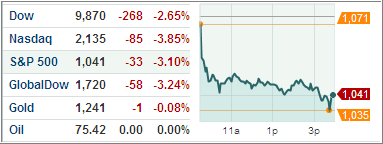 Reader Rick emailed the following question:
Reader Rick emailed the following question:
I have been reading several blogs and newsletters that are stating that the US may be looking at a Double Dip recession later this year but even more so in 2011. What is your take on this possibility?
Also, I am seeing more and more mention of deflation without much being said about where to position a portfolio or what to invest in if deflation does hit. Would you please comment on a deflationary scenario?
Yes, I think a slide back into a recession is a distinct possibility. Actually, we might be still in one had it not been for the reckless spending of trillions of stimulus dollars. Since we are on the back side of busted real estate/credit bubble, we are a bit in unchartered territory, the exact outcome of which is still an unknown.
There is no way to anticipate what will happen and what your future portfolio should look like. The beauty of trend tracking is that we don’t have to guess. We first determine where the major trend is at. Right now, domestically, we’re still dancing above/below the long-term trend line by a small percentage with a potential break below it lurking in the near future.
Once that happens, we will have to evaluate which areas are still showing increasing momentum figures as featured in my weekly StatSheet. Then we can determine if any sectors have merit or if outright short investments via ETFs like SH or SDS are sensible.
Trying to establish positions now or making major portfolio changes in anticipation of deflation or double dip recession makes no sense to me. As always, my recommendation is to wait and let market show us the way.
Looking at the big picture, if you were to divide the investment world into 5 major asset classes, you might come up with the following:
Bonds (+1.95%)
U.S. Stocks (-7.95%)
Foreign Stocks (-9.26%)
Commodities (-9.56%)
Real Estate (-0.66%)
All of these 5 are well represented in the ETF world and can be bought at anytime. The numbers in parentheses (as of 7/2/10) represent the percentage each asset class is positioned above or below its respective long-term trend line indicating whether it is in bullish or bearish territory.
All are in bear market territory with the exception of bonds. That pretty much tells you the current state of affairs as to where the major trends are headed. Given that fact, I think trying to outguess market direction and attempt to position a portfolio at this time is like trying to catch a falling knife.
Stay in those areas where the momentum is, which currently is in bonds and selectively on the short side of the market until directional changes become apparent.
Patience is crucial as we may be slipping into an economic environment for which there has been no precedent.





